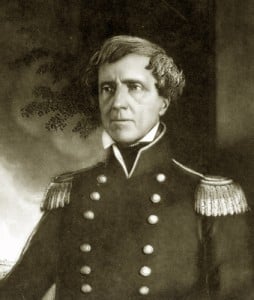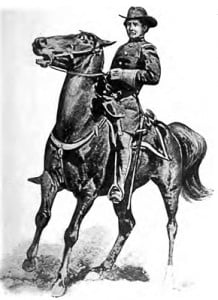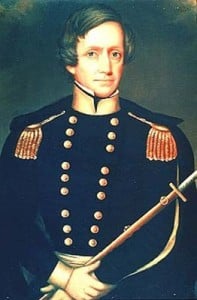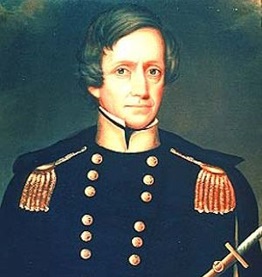Ask A Librarian, California History, People, St Helena
Ask A Librarian: Kearney Street
Where did Kearney Street in St. Helena get its name?
 Kearney Street in St. Helena, California, is one of the older streets in the city. Although it contains mostly modest single-family homes, many well-known public servants grew up on there. For more than 125 years, civic servants and local officials have resided on the quiet residential street. According to a 2004 article from the Napa Register by David Ryan:
Kearney Street in St. Helena, California, is one of the older streets in the city. Although it contains mostly modest single-family homes, many well-known public servants grew up on there. For more than 125 years, civic servants and local officials have resided on the quiet residential street. According to a 2004 article from the Napa Register by David Ryan:
Among Kearney Street’s more notable residents are Congressman Mike Thompson, former county Supervisor Mel Varrelman, St. Helena City Councilman Eric Sklar, deputy district attorney Lee Philipson and Local Agency Formation Commissioner Guy Kay.
That’s not counting Napa Valley Wine Auction Boosters, past St. Helena mayors Lowell Smith and Louis Stralla; former resident and current Napa County Superior Court Judge Richard Bennett, fire chiefs, police officers and one forestry official – all of whom have lived on the street over the past several decades…
While the list is lengthy, few longtime residents can name a reason that the street has been home to so many public servants for so long.
“I think it’s the water,” joked Varrelman. “Yeah, I don’t know, it’s just one of those things.”[1]
Even before the city of St. Helena was founded, many of its earliest citizens participated in the Bear Flag Revolt and Mexican-American War. Many of Napa’s earliest pioneers – men such as Nathan Coombs, founder of Napa City, and John Grigsby and William Ide, leaders of one of the first wagon trains to California – participated in the Bear Flag Revolt, and their names often adorn local streets and neighborhoods.
Of the Mexican-American War, two prominent military leaders were each honored with a street named for them in St. Helena. “In July 1846 – shortly after the Bear Flag Revolt in Sonoma – Commodore Robert F. Stockton sailed down the coast to San Diego and landed troops in San Diego and Los Angeles to battle the Mexican army. He was met by Brigadier General Stephen Watts Kearny, whose name is often misspelled ‘Kearney,’ as it is in St. Helena.”[2] This is the same Kearny for whom the street in San Francisco is named. His name also graces a street in Fort Leavenworth, the San Diego neighborhood Kearny Mesa, Camp Kearny (a United States military base in San Diego that operated from 1917 to 1946), Fort Kearny in Nebraska, two cities – Kearny, Arizona, and Kearney, Nebraska – and numerous schools throughout the West.
 Kearny was born in Newark, New Jersey, in 1794 to Philip Kearny, a wealthy landowner and wine merchant, and Susanna Watts. Military success and fame ran in Kearny’s family. On his mother’s side, he was the grandson of merchant Robert Watts of New York and Mary Alexander, the daughter of American Revolutionary War major-general William Alexander and Sarah Livingstone. His nephew, Major General Philip Kearny, would become famous in his own right during the Civil War. Stephen Kearny married Mary Radford, the stepdaughter of William Clark from the Lewis and Clark Expedition, in the 1820s, and they had eleven children, five of whom survived to adulthood.
Kearny was born in Newark, New Jersey, in 1794 to Philip Kearny, a wealthy landowner and wine merchant, and Susanna Watts. Military success and fame ran in Kearny’s family. On his mother’s side, he was the grandson of merchant Robert Watts of New York and Mary Alexander, the daughter of American Revolutionary War major-general William Alexander and Sarah Livingstone. His nephew, Major General Philip Kearny, would become famous in his own right during the Civil War. Stephen Kearny married Mary Radford, the stepdaughter of William Clark from the Lewis and Clark Expedition, in the 1820s, and they had eleven children, five of whom survived to adulthood.
During the War of 1812, Kearny left Columbia College after two years to join the US Army. He fought in the Battle of Queeston Heights on October 13, 1812, the first major battle of the war, and was wounded and taken as a prisoner of war. He was paroled, and continued his service in the military, quickly moving up in the ranks. In 1819, Kearny went along with Colonel Henry Atkinson on his famous Yellowstone Expedition; in 1823 he also participated in the Second Yellowstone Expedition. His military career was highlighted by a series of prominent events:
Kearny fulfilled an important task by helping establish the Jefferson Barracks, St. Louis, Missouri, in 1826; he subsequently commanded numerous frontier posts, including Fort Crawford, Wisconsin Territory, through 1830…When the First Dragoon Regiment was created in 1833, Kearny became lieutenant colonel as of 4 March. He rode in General Henry Leavenworth’s ill-fated Southern Plains Expedition of 1834 and succeeded him as colonel on 4 June 1836. From his headquarters at Fort Leavenworth, he composed a noted tract, Carbine Manual; or; Rules for the Exercise and Maneuvers for the U. S. Dragoons (1837). Kearny was also active in peace and treaty negotiations with various Indian tribes, and in 1842 he was rewarded with command of the Third Military District, encompassing most of the Great Plains region. Among his final peacetime activities was conducting a major expedition along the Oregon Trail to South Pass in 1845 and establishing Fort Kearny (Nebr.) the following year.[3]
 At the start of the Mexican-American War in 1846, Kearny was promoted to Brigadier General and made Commander of the Army of the West. He took 1,660 men south to Santa Fe, New Mexico, and conquered the city without bloodshed a month later. In December 1846, nearly 5 months after the end of the Bear Flag Revolt, Kearny marched into Los Angeles with 100 dragoons. It took several battles and the loss of many lives before he was finally able to subdue San Diego and Los Angeles, thus securing Southern California for the United States.
At the start of the Mexican-American War in 1846, Kearny was promoted to Brigadier General and made Commander of the Army of the West. He took 1,660 men south to Santa Fe, New Mexico, and conquered the city without bloodshed a month later. In December 1846, nearly 5 months after the end of the Bear Flag Revolt, Kearny marched into Los Angeles with 100 dragoons. It took several battles and the loss of many lives before he was finally able to subdue San Diego and Los Angeles, thus securing Southern California for the United States.
Kearny ran afoul of naval Commodore Robert Field Stockton and his associate, John C. Frémont. When Stockton appointed Frémont to act as governor, the latter refused to heed any of Kearny’s orders. Kearny had him arrested and court-martialed, ruining Frémont’s political reputation. (As an interesting side note, while Kearny and Frémont were traveling back to Fort Leavenworth for the court-martial, they came across and buried some remains of the infamous Donner Party. Some of the survivors had settled in Calistoga, where their descendants live to this day.) Later, when he returned from battles in Mexico, he was awarded the promotion of Brevet Major General against the wishes of Frémont’s father-in-law, Senator Jesse Hart Benton. Kearny was appointed as Military Governor of California, Veracruz, and Mexico City. Kearny died in 1848 of complications from yellow fever, contracted during his campaign in Veracruz. “Kearny was an archetypal frontier officer: gruff, inflexible, and blunt to the point of tactlessness…Next to Henry Atkinson, he was perhaps the most effective frontier officer of the antebellum West.”[4]
[1] David Ryan. “St. Helena’s long-time power alley: Kearney St.” Napa Register. February 24, 2004. http://naparegister.com.
[2] Lin Weber. Old Napa Valley. St. Helena Star. March 26, 1998.
[3] J. C. Fredriksen. Stephen Watts Kearny. American National Biography. 2010. EBSCOHost.
[4] Ibid.


